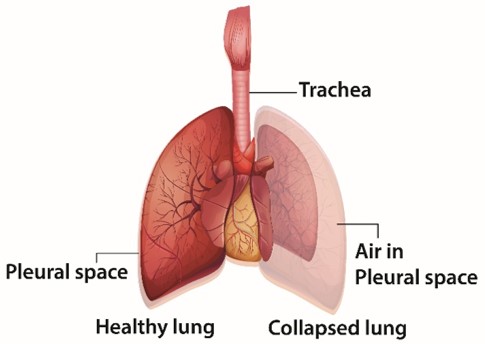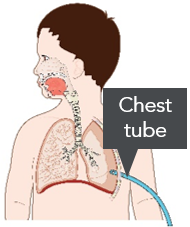Download PDF, 1.31MB, PDF
What is Pneumothorax?
Pneumothorax refers to the abnormal accumulation of air in the pleural space (the space between the lung and the chest wall).
This happens when air leaks out from the lungs, or leaks into the pleural space through the chest wall, causing the lung to collapse and affect breathing.
A pneumothorax may be life-threatening.

Symptoms
Some people with a small pneumothorax may not experience any symptoms, and the pneumothorax may only be detected unintentionally on a chest X-ray.
In other cases, common symptoms experienced include:

Causes
A pneumothorax may happen in a person with no prior lung condition. However, common causes of pneumothorax include:
- Injury to the lungs e.g. post-procedure (needle biopsy), trauma (rib fractures)
- Smoking
- Lung conditions such as chronic obstructive pulmonary disease, bronchiectasis
- Certain lung infections
Diagnosis and Management
This includes:
- Chest X-ray
- Computed Tomography scan of the chest
- Ultrasound
Treatment
Treatment will depend on the severity and overall condition of your lungs.
Oxygen & Monitoring
Your doctor may admit you to the hospital and give you oxygen. Repeated chest imaging will be done to monitor if the pneumothorax resolves on its own or if further intervention is required.
Chest Tube Insertion
In other cases, a chest tube may be inserted to remove the accumulated air in the pleural space. This will allow the lungs to re-expand and help relieve your symptoms.

Surgery
Depending on the progress and cause of the pneumothorax, you may be advised to undergo surgery for treatment as well as for prevention of a recurrence (i.e. occurring again in the future). This will involve a referral to the cardiothoracic surgeons.
Prevention
Sometimes a pneumothorax may occur again.
If you smoke, you should stop smoking.
Depending on your underlying lung condition, risk of recurrence and suitability of treatment, your doctor may discuss with you some options such as pleurodesis or surgery.
Talc pleurodesis is a procedure where a medicine called talc slurry is administered into the chest tube that has been inserted into the pleural space.
What Should I Take Note of After a Pneumothorax?
As a pneumothorax may reoccur, you should seek medical attention immediately if you experience symptoms such as chest pain and shortness of breath.
If you participate in activities involving a change in air pressure (such as flying in an aeroplane or scuba diving), you should also check with your doctor when it is safe to resume these activities.
